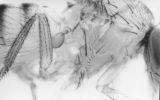      
|


      
|


Gemkow, Mark J. 1999. Fly-FISHing: A protocol to localize single copy genes inside the nucleus in whole mount embryos.
Dros. Inf. Serv. 82: 91-94. View PDF
The nucleus is the place where transcription factors, DNA- and RNA-polymerases fulfill their tasks. The chromatin is made up of an undefined number of proteins which all contribute to the way the information contained in the genome is utilized. How the nucleus is organized and how all the processes are interwoven inside the nucleus is an open and ongoing area of debate (the following books give a good overview of this field: Chromatin: Structure & Function, Alan Wolffe, 1998; Chromatin Structure and Gene Expression, Ed. Sarah C.R. Elgin, 1995; CSH Symposia on Quantitative Biology Vol. 58, 1993). Antibody stainings to proteins involved in mitosis and transcription revealed complex and dynamic patterns (Buchenau, 1993a, b, 1997). Drosophila offers a unique system to study changes in nuclear architecture and to reveal the dynamics of these processes. This can be done by injection of fluorescently labeled antibodies into Drosophila embryos or by using the GFP-technology for in vivo studies (Amsterdam et al., 1995; Davis et al., 1995; Yeh et al., 1995). Alternatively fixed embryonic material can be extremely helpful for visualizing dynamics in changing structures because in each set of experiments different developmental timepoints are represented which can be sorted to reflect the developmental progression. In this technical note I describe a fluorescent in situ technique which can be used to localize single copy genes in three dimensions inside the nucleus. This technique was successfully used to determine the pairing kinetics of the Bithorax-complex (BX-C) during embryogenesis and to gain insights into the mechanism of transvection (Gemkow et al., 1998, 1993). Localization and pairing studies for chromosomal loci on the second chromosome were also performed (Hiraoka et al., 1993; Fung et al., 1998 and references therein). The protocol given here can also be used in combination with antibody stainings inside the nucleus which enabled us to co-localize the BX-C with proteins of the Polycomb-group. For this purpose a regular antibody protocol has to be performed after hybridization. An alternative protocol from Gunawardena and Rykowski (1994) can be found in: Drosophila melanogaster: Practical Uses in Cell and Molecular Biology; edited by Goldstein and Fyrberg (Methods in Cell Biology, Vol. 44).
Overnight collections or embryos of any desired stage of Oregon R were dechorionated with 50% bleach for 3 min in a small basket. Embryos were thoroughly washed with 0.1 M NaCl containing 0.03% Triton X-100 followed by Millipore water. Embryos were then fixed with 4% para-formaldehyde in buffer A (60 mM KCl, 15 mM NaCl, 0.5 mM spermidine, 0.15 mM spermine, 2 mM EDTA, 0.5 mM EGTA, 15 mM PIPES, pH 7.4) and heptane (1 part buffered para-formaldehyde + 9 parts heptane) for 30 min at room temperature on a mini-shaker with eccentric rotation at 1000 rpm. After fixation the aqueous phase was taken off and embryos were devitellinized with a 1:1 mixture of heptane and methanol for 2 min by thoroughly mixing on a vortex. All embryos which sank to the bottom were washed twice with methanol and stored in 100% methanol at -20°C if not used immediately.
We used the following P1 clones from the collection originally described by Hartl et al. (1994) and provided by EMBL Heidelberg: DS 03126, DS 00846 and DS 0769. These represent parts of the Ultrabithorax (Ubx), abdominal-A (abd-A) and Abdominal-B (Abd-B) genes, respectively.
Probes were labeled by random priming: 100-1000 ng of template were mixed with 0.1 mM dXTPs, 0.065 mM dTTP, 0.035 mM DIG and 0.6 OD260 units of hexanucleotide primer in a volume of 40 µl. The probes were denatured for 15 min in a boiling water bath. 10 µl of 5 times concentrated Klenow buffer (final concentration: 50 mM Tris-HCl pH 7.6, 5 mM MgCl2, 2 mM DTT) and 5 units of Klenow enzyme were added and the reaction was incubated overnight at 37°C. The reaction was stopped by boiling for 5 min. Unincorporated nucleotides were removed by gel filtration through BioRad MicroSpin 30 using 1xSSC as buffer. Labeling efficiency was checked with a spot test on nitrocellulose using an alkaline phosphatase color reaction. Incorporation was judged as adequate if 10 -100 pg of labeled probe were detectable in this test. To decrease probe length, probes were sonicated 12 times for 30 sec with 15 sec cooling intervals on ice. This procedure yielded a probe length which peaked between 200 and 300 bp. For the hybridization 600 - 1000 ng of the labeled probe were precipitated with 10 µg of human cot1 DNA and 100 µg of yeast tRNA as carrier, dissolved in 10 µl of formamide and mixed with 10 µl of 8xSSC, 200 mM Na-PO4 pH 7.0, 0.2% Tween 20 to reach the final concentrations used in the hybridization mixture. Denaturation was effected by boiling for 5 - 15 min, probes were then added to the embryos without prior cooling.
Fixed embryos were transferred stepwise to PBT (phosphate-buffered saline + 0.1% Tween 20) and incubated with 100-200 µg/ml RNAse A in PBT for at least 3 h at room temperature or overnight at 4°C. Embryos were transferred into the hybridization mixture via a step-gradient of 20, 50, 80 and 100% hybridization mixture (50% formamide, 4xSSC, 100 mM Na-PO4 pH 7.0, 0.1% Tween 20), 20 min each step. All steps were done in a conical tube in a volume of 1 ml on a rotating wheel. The embryonic DNA was denatured for 15 min at 76°C in hybridization mixture. While the embryos were still at 76°C, as much buffer as possible was taken off and the denatured probe was added. The hybridization was performed on a thermomixer at 37°C with gentle agitation for 14-17 h. Post hybridization washes of 20 min each, were carried out at 37°C in a volume of 1 ml in the following order: 50% formamide, 2xSSC, 0.3% CHAPS; 40% formamide, 2xSSC, 0.3% CHAPS; 30% formamide (twice), 70% PBT; 20% formamide, 80% PBT; 10% formamide, 90% PBT; PBT (twice). Embryos were thereafter washed with PBT at room temperature and stored at 4°C if not immediately used for the detection reactions. Hybridization of the DIG-labeled probe was detected by immunofluorescence. Embryos were blocked with 3% BSA in PBT for at least 3 h at room temperature. Thereafter they were incubated with Cy3-labeled polyclonal anti-DIG Fab-fragments and monoclonal anti-lamin antibody (Risau et al. 1981) overnight at 4°C and washed 3´30 min with PBT. The lamin signal was detected with Cy5-labeled F(ab)2-fragments goat-anti-mouse (Dianova, Jackson Labs, Hamburg, Germany). The DNA was counter stained for 5 min with 5 µM DAPI (Serva, Heidelberg, Germany). Embryos were stepwise transferred to Mowiol 4-88 (Hoechst, Frankfurt, Germany).
The antibodies against lamin were purified from cell culture supernatants by chromatography on a protein G Sepharose column (Pharmacia, Upsala, Sweden) before use. Cy5-labeled secondary goat IgG anti-mouse F(ab)2 fragment antibodies were purchased (Dianova, Jackson Labs). Fab fragments from a sheep anti-digoxigenin antibody (Boehringer, Mannheim, Germany) were labeled with Cy3 hydroxysuccinimide (Amersham, Buckinghamshire, UK) using a protocol previously described (Buchenau et al., 1993a).
A Zeiss 310 CLSM equipped with two internal lasers (He-Ne, 633 nm; argon ion, 488 and 514 nm) and three external lasers (He-Ne, 594 nm; He-Ne, 543 nm; argon ion, 364 nm) coupled by single-mode fiber optics was used for all measurements. Fluorophores were observed under the following conditions: Cy5, excitation at 633 nm, emission with longpass 665; Cy3, excitation at 514 nm, emission with bandpass 535 - 580 nm; DAPI, excitation at 364 nm, emission with longpass 410 nm or bandpass 450 HW40. The objective lenses used had a high numerical aperture. Primarily the Zeiss Plan Apochromat 63x, NA 1.4 was used. The voxel size was selected, so as to be three times smaller than the optical resolution of the microscope: 100x100x250 nm3 (x,y,z).
The image data from the CLSM were processed in SCIL IMAGE (TNO Institute of Applied Physics, TU Delft, The Netherlands), IMARIS 2.4 (Bitplane, Zürich, Switzerland), and NIH Image (National Institute of Health, Bethesda, Maryland, USA) for selection of regions of interest, smoothing, overlays, 3-D reconstructions and intensity calculations. All image processing was carried out on a Silicon Graphics Workstation.
In principle any kind of DNA probe can be used from small vectors over lambda clones up to P1 clones. In my experience the P1 clones worked best because they gave reasonable sized signals. In an experiment one has to find a compromise between probe size, labeling quality and fluorescence signal. The P1 clones which I used in my experiments in combination with a single directly labeled antibody gave signals with a diameter between 400 nm and 1 µm and had enough fluorescent signal to allow three dimensional scans with a conventional Zeiss Laser scanning microscope. By using two or multiple layers of antibodies, signal size can be increased. An alternative for very small probes is the amplification of the signal with a peroxidase reaction using fluorescently labeled tyramids (Gemkow et al., 1993 and references therein).
In my experience the incorporation of digoxigenin by random priming using Klenow fragment worked best but one can also think of using random primed PCR or nick translation to label the probes. An alternative to digoxigenin are fluorescently labeled nucleotides which are now available in a great variety having for example Cy3, Fluoresceine or Alexa dyes as labels and can be purchased from companies like Amersham or Molecular Probes. But again one has to take into account probe size and labelling intensity to match the needs for fluorescent microscopy.
All steps in the procedure should be given great care, but in general the most important things are the size of the labeled probe and the denaturation temperature applied to the embryos. For example if the probe size is too long, the probe cannot penetrate the tissue efficiently. This will probably have more of an effect than in the protocol of Tautz and Pfeifle (1989) because a Proteinase K digestion is omitted. Omitting the Proteinase K is important to be able to co-localize proteins with the hybridization signal. The signal intensity increases by increasing the denaturation temperature for the embryonic DNA. But one has to find a compromise between an efficient denaturation and destruction of the morphology. A good value is 76 °C but this of course also depends on the target sequences and the developmental stage of the embryo. I therefore suggest trying out different temperatures and comparing the signals in the microscope. Acknowledgments: The protocol presented was developed in the laboratory of Dr. Donna J. Arndt-Jovin.
References: Amsterdam, A., S. Lin, and N. Hopkins 1995, Dev. Biol. 171: 123-129; Buchenau, P., H. Saumweber, and D.J. Arndt-Jovin 1993a, J. Cell Sci. 104: 1175-1185; Buchenau, P., D.J. Arndt-Jovin, and H. Saumweber 1993b, J. Cell Sci. 106: 189-199; Buchenau P., H. Saumweber and D.J. Arndt-Jovin 1997, J. Cell Biol. 137: 291-303; Cold Spring Harbor Symposia on Quantitative Biology Vol. 58, 1993, DNA and Chromosomes; Cold Spring Harbor Laboratory Press; Davis, I., C. Girdham, and P. O'Farrell 1995, Dev. Biol. 170: 726-729; Elgin, S.C.R. (editor) 1995, Chromatin Structure and Gene Expression, IRL Press, Oxford; Gemkow, M.J., P. Buchenau, and D.J. Arndt-Jovin 1993, Bioimaging 4: 107-120; Gemkow, M.J., P.J. Verveer, and D.J. Arndt-Jovin 1998, Development 125: 4541-4552; Gunawardena, S., and M. Rykowski 1994, Meth. Cell Biol. 44: 393-409; Hartl, D., D. Nurminsky, R. Jones, and E. Lozovskaya 1994, Proc. Natl. Acad. Sci. USA 91: 6824-6829; Hiraoka, Y., A.F. Dernburg, S.J. Parmelee, M.C. Rykowski, D.A. Agard, and J.W. Sedat 1993, J. Cell Biol. 120: 591-600; Risau, W., H. Saumweber, and P. Symmons 1981, Exp. Cell Res. 33: 529-541; Tautz, D., and C. Pfeifle 1989, Chromosoma 98: 81-85; Wolffe, A., 1998, Chromatin: Structure & Function, Academic Press, San Diego; Yeh, E., K. Gustafson, and G.L. Boulianne 1995, Proc. Natl. Acad. Sci. U.S.A. 92: 7036-7040.